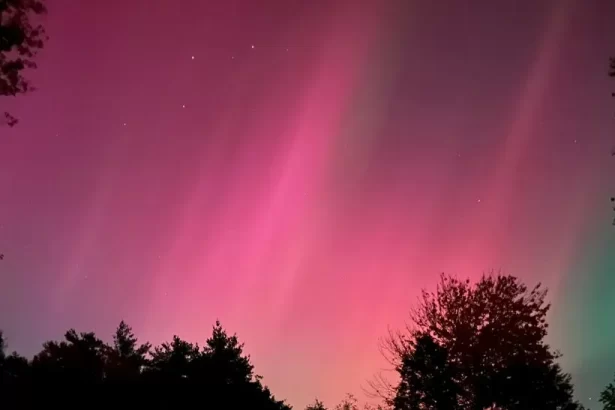The northern lights, also known as the aurora borealis, have captivated observers with their stunning displays of color dancing across the night sky. Reports of vibrant sightings have been abundant, with many people experiencing the phenomenon as far south as Kent in the UK. As excitement builds, let’s delve into what causes this mesmerizing spectacle and how you can catch a glimpse of it.
What Are the Northern Lights?
The northern lights are bright, dynamic curtains of color that illuminate the night sky in the northern hemisphere. Their southern counterpart, known as the aurora australis, can be seen in the southern hemisphere. These stunning displays are the result of solar activity. Specifically, during events called coronal mass ejections (CMEs), the sun releases plasma—a super-hot gas composed of charged particles.
When these charged particles travel towards Earth, they interact with the planet’s magnetic field, leading to geomagnetic storms. Some of these particles are directed towards Earth’s magnetic poles, where they transfer energy to atmospheric gases such as oxygen and nitrogen. This transfer of energy causes these gases to emit light, creating the vibrant auroras we observe.

Viewing Opportunities
As many have experienced in recent nights, sightings of the northern lights have become increasingly common. Following an impressive display on Thursday night, there are chances to see the aurora again on Friday, although visibility may vary. According to the UK Met Office, the likelihood of auroral activity persists but will gradually decrease through October 11, becoming more confined to higher latitudes by October 13.
For those in the UK, particularly in Scotland, the prospects remain promising. However, cloud cover may obstruct views, so clear skies are ideal for optimal sightings. In the southern hemisphere, sightings in Tasmania and New Zealand may also diminish, with the aurora expected to become limited to high latitudes as the weekend approaches.
Across the Atlantic, data from the Space Weather Prediction Center indicates that the northern lights could be visible in parts of North America on Friday night. Areas such as Canada and northern U.S. states including Minnesota, North Dakota, Washington, and Montana are expected to have better chances of experiencing this celestial phenomenon.
Tips for Viewing and Photographing the Aurora
If you’re hoping to witness the northern lights, here are some tips to enhance your experience:
- Get Away from Light Pollution: To fully appreciate the aurora, find a location away from city lights and other sources of brightness. Darker settings will allow the colors of the aurora to stand out more vividly.
- Use a Camera: The aurora might not appear as colorful to the naked eye, so capturing it with a camera is a great way to reveal its beauty. Utilize a long exposure or night mode setting to enhance your photographs. The longer the exposure time, the more light your camera can capture, resulting in a brighter image.
- Steady Your Camera: To avoid blurry photos, use a tripod to keep your camera steady during long exposures. Additionally, remember to turn off the flash, as it can wash out the colors of the aurora.
- Be Patient: Aurora activity can fluctuate significantly, with visibility increasing and decreasing in just a few minutes. Staying in one place and waiting patiently may yield rewarding views.
Why So Many Sightings This Year?
The surge in aurora sightings this year is attributed to the sun nearing the peak of its 11-year solar activity cycle. During this time, CMEs occur more frequently, enhancing the chances of witnessing the northern lights. This heightened solar activity has enabled observers to see the aurora further south than usual, making it an exciting time for enthusiasts and casual viewers alike.
The northern lights are a breathtaking natural phenomenon that continues to fascinate people worldwide. Understanding the science behind the auroras and knowing when and where to look can enhance your chances of witnessing this incredible display. Whether you’re an experienced photographer or simply hoping to catch a glimpse, the magic of the aurora borealis awaits. Don’t miss your opportunity to witness one of nature’s most spectacular light shows!



